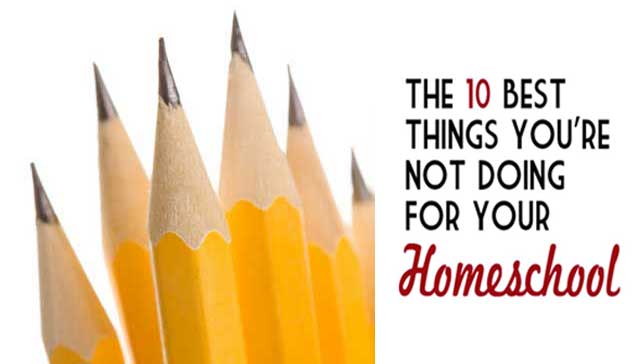
If we’re really being honest with each other, as much as we may love it, the internet can be a big ol’ time suck.
We turn to the online world with a desire to make our homeschool better, but often the best gets lost amidst all of the good, not-so-good, or just plain distracting ideas.
Shiny crafts and printables abound on Pinterest. Forums are filled with opposing curriculum recommendations. Blogs (including this one) feature an abundance of ideas. And it’s mostly good stuff.
But sometimes what we really need in our quest for the better homeschool are actions — things we can do today that will improve the quality of education we are giving our children because they are not just good things, but the best things. And these are those best things.
Doing just one of the ten actions below will raise the standard of education in your home. Do more for an even bigger effect. They are easy to implement and you might find that you enjoy them so much more than other things that have been filling your day.
Best Things free eBook
Love this post? Now you can get it as an ebook absolutely free. Fill out the form to get your copy today!
Action #1: Read out loud to your kids more
Simple steps
- Peruse a good book list and choose a book age-appropriate to read aloud. If you have a wide range of ages, shoot for the middle of the pack. Good family-friendly read alouds for starting include The Wonderful Wizard of Oz, fairy tales, The Penderwicks, and The Lion, the Witch, and the Wardrobe.
- Resign yourself to the fact that read-aloud time does not have to be quiet and serene to be effective. Set up some simple rules like “you are free to play with any quiet toy as long as you are listening” and “keep your hands to yourself”.
- Just get started. Commit to five minutes a day to begin and build the habit from there. Download the free Quickstart Guide to Great Conversations with Your Kids About Books for the support and tools you need to begin simple conversations with your kids about what you are reading.

Pudewa insists we should start reading aloud to kids while they are young, but it is perhaps even more important to read to them after they get older too. He suggests reading to your kids for hours each day, so whatever you are doing likely isn’t enough.
Sarah Mackenzie, the host of the Read Aloud Revival Podcast, declares better relationships are the greatest benefit of extended read-aloud sessions. Kids will better remember books you have read to them and talked about with them. According to Mackenzie, the simple act of reading together will strengthen the relationships in your family.
Additional resources
Action #2: Choose more classic books
Simple steps
- For help choosing age-appropriate classics, consult this list.
- Peruse your personal homeschool book list and replace every third book with a work of classic literature instead.

Historical fiction may include historical facts packaged in an enjoyable package, modern stories may be fun and engaging, and non-fiction may be necessary at times, but all are milk compared to the cream of classic literature.
To fully shape the moral imagination of our children, we need to feed them a diet of cream and consume less watered-down milk.
Additional resources:
Action #3: Memorize a poem
Simple steps
- Choose a short enjoyable poem for memorization like a selection by Robert Louis Stevenson, Hilaire Belloc, or Christina Rossetti.
- Read the poem aloud daily with your kids until they have it memorized — I bet they do it quicker than you do!
- Lather, rinse, and repeat with another poem.
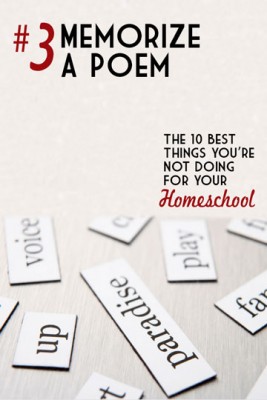
A child’s instinctive desire to memorize is intrinsic to language acquisition. Yet for the most part, we ignore it, or allow it to happen so haphazardly that we miss out on one of the greatest opportunities to build sophisticated language patterns. Poetry has long served a critical role in the transmission of culture, as it tends to convey the “rhyme and reason” of life in a concentrated and memorable form. But if we don’t provide the content and opportunity for organized memorization, kids will let popular culture be their teacher. In other words, if we don’t provide them with Belloc, Stevenson, and Rossetti, they’ll memorize McDonald’s commercials and Snoop Doggy Dog rap lines. Memorization is not only natural for young children. It is culturally powerful and educationally essential.
So if we want our children filled with the worthy, then we have to fill their heads (and hearts) with content of our own choosing.
Poetry is not the only content worthy for memorization, but it is often the easiest, so a good place to start. Scripture, selections from Shakespeare, great speeches, and helpful tools (like math facts or Latin chants) are easily added to your repertoire once the memory habit is established.
Additional resources
- Memorization and the Soul: Why, What, and How
- The Ultimate Guide to Memory Work
- Help Your Kids Memorize Anything
Action #4: Do fewer subjects
Simple steps
- List out every subject that you do in your homeschool each day
- Turn a critical eye towards this list and put a star beside those subjects you would consider truly necessary for your student’s success
- Carefully consider eliminating most of the subjects without a star beside them
- Research alternate schedule ideas
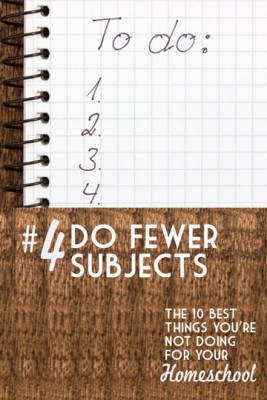
Elementary students need mastery of the skill subjects of language arts and math, plus a rich diet of classics read aloud (see above), tons of outdoor play, and interesting field trips (see below).
Moving into the middle and high school years, add more subjects but use creative scheduling techniques like block scheduling or loop scheduling. This will limit the number of subjects studied in any one day, yet the student will still accomplish all the necessary subjects.
Additional resources
Action #5: Plan a field trip
Simple steps
- Peruse local websites, the chamber of commerce or homeschooling resources and pick a place to visit
- Either alone or with a group, visit a museum, performance, science or nature attraction, local business — anywhere to learn
- Once there explore, read, discuss, enjoy
- Repeat often
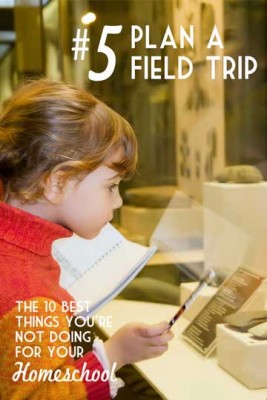
We spend our time reading about the natural world instead of being in the natural world. We look at pictures of things in books instead of seeing them in person. We listen to recordings of music instead of watching a live performance.
Homeschooling gives us the freedom to take advantage of so many more opportunities than our schooled counterparts. While informal, the education we receive while attending the theater, a national park, or the art museum is just as valid as the formal education we receive while sitting at a desk — and often more effective.
Our lives should be as rich with these opportunities as our budget and schedule will allow.
Additional resources
- The Ultimate Guide to Field Trips for Homeschoolers
- Your State Tourism Board
- Official Museum Directory
Best Things free eBook
Love this post? Now you can get it as an ebook absolutely free. Fill out the form to get your copy today!
Action #6: Become a life-long learner yourself
Simple steps
- Start a book club of other homeschool moms to read classics or study homeschooling books like Charlotte Mason’s works
- Take a class either at a local venue or online. Learn a new skill or creative endeavor
- Develop yourself professionally as a homeschool teacher by attending a local conference, a state or national convention, or through audio lectures and online resources

Beyond this, you will be the first and most influential learning model your student will see. If you approach new projects and concepts with curiosity, humility, and a positive attitude, your children are likely to respond similarly. It is important that they see you actively pursue topics that interest you, because there are no greater catalysts for learning than curiosity, interest, and wonder.
In addition to modeling learning, the act of learning ourselves reminds us of the difficulties of being a student.
As I struggle to learn to knit, I have a greater empathy for my kindergartener struggling with letter formation. I am reminded of how difficult learning a new skill is and how often I need to practice with patience to master it.
Additional Resources
- A Collection of Great Audio Lectures and Podcasts for Homeschoolers
- Book Discussion 101
- Start Here: A Journey Through Charlotte Mason’s 20 Principles
Action #7: Hold a poetry tea time
Simple steps
- Put water on to boil while you have the children set the table with linens, gather teacups and plates, and devise a centerpiece (candle, simple nature display, flowers from the yard)
- Pour everyone’s favorite hot drink (sometimes we do tea, sometimes we do hot chocolate) and set out a simple snack. It can be store-bought or homemade
- Grab a collection of poetry books, your current read aloud selection or some treasured picture books
- Eat, drink, and be merry as you share, read, and discuss.

Ritual is extremely important in the formation of family culture and the ability to set aside time from the busy whirl. Time set apart is special, cherished, treasured, and remembered. Does it have to involve tea? Or poetry? Neither are necessary, though both are nice.
Some homeschool family tea rituals might revolve around religious practices, others might have a standing read-aloud time after dinner in the evening. The important thing is to choose the ritual, make it a moment set-apart either by the food you eat, the decor, the action, or a combination of any of those, and to be consistent with its practice.
Additional resources
Action #8: Be consistent
Simple steps
- Change your mindset to one that allows you to see homeschooling as your part-time job.
- Get up every morning and act just like you would if you were going to work! If you consider not homeschooling that day for some reason, pretend you have to call a boss and explain.
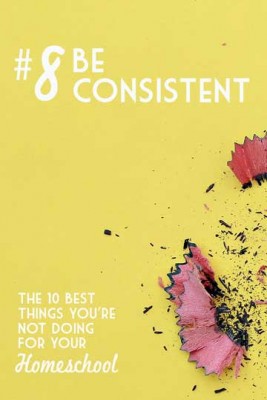
The more the kids get into a routine of waking every single day, sitting and doing school, the easier it will be for everyone, regardless of your method of education.
Whatever you choose to do for school, do it routinely. The kids will come to know what is expected of them, they will argue and fight with you less, and it will get easier as you go along. End of story.
Additional resources
- Stay Motivated and Consistent in Homeschooling
- Daily Faithfulness
- Be Careful About Letting Life Derail the Home Education Train
Action #9: Plan a morning time
Simple steps
- Make a list of subjects or activities which you feel are important, but often get the short shift in your schedule and set aside for more scholarly pursuits. These could include reading aloud, memorization, picture study, composer study or music appreciation, prayer, Bible study, etc. The key to morning time is that these are all subjects that the entire family can do together as a group.
- Use the post Six Steps to Plan a Circle Time to draft the first plan. Jot this down in a notebook with a pencil.
- Live your plan for a while. You will likely change a few things, drop a subject, add a reading, switch things around. Eventually, a habit will develop that will become routine.

From Cindy Rollins:
“That is what MT (Morning Time) is. It is the daily collection of little grains of time that add up to a lifetime of learning. It is the daily sowing of the seeds of learning for the long haul … Over the years, MT has kept the same structure but it can also be fluid as to categories. I think it is a great place to put all those categories which fall outside the usual school routine: composer study, artists, Plutarch and Shakespeare, even nature notebooks are each perfect for MT because these are the important things that often get squeezed out of the traditional school day. We may even find when we scoot over just a couple minutes a day to make room for these easily neglected areas the connections the mind begins to make start circuits for our children which far surpass the mundane teaching of subjects (emphasis mine)
I have read the complaint from a mom in an online forum that she did not need to name these practices and put them in a basket — she had been doing all of these things for years. I say good for her.
BUT the act of naming something (basket optional) is at the very heart of its existence. The first thing Adam did in the garden was name the animals. This naming is important stuff. By giving a name to a set of practices we do (a liturgy, if you want) we elevate it, makes it more than what it was before.
The practices of morning time — prayer, reading aloud of worthy literature, memorization, singing, the arts, discussion — are the very heart of human learning, and the most important things you will do all day. Call it what you will, but name it, own it, and let your homeschool be transformed.
Additional Resources
- The Long Haul: On Morning Time
- Cindy Rollins’ 31 Day Series on Morning Time
- What to do in Morning Time
Action #10: Replace a textbook with a living book
Simple steps
- Choose one text that is sucking the life from your studies, one that everyone dreads or has become dry and boring.
- Research alternatives by chatting with friends, perusing online forums, or searching book lists. Strive to find a living book (fabulous definition and websites with lists at that link).
- Put the text aside and instead use the living book to complete your studies.

Living books are usually written by one person who has a passion for the subject and writes in conversational or narrative style. The books pull you into the subject and involve your emotions, so it’s easy to remember the events and facts. Living books make the subject “come alive.” They can be contrasted to dry writing, like what is found in most encyclopedias or textbooks, which basically lists informational facts in summary form.
Brandy Vencel calls living books the “medium of ideas” as opposed to fact. Since we want to fill our children’s heads with big ideas instead of small facts, living books are a valuable way to learn.
Living books will interest our students, make them think about the topic at hand, and prompt discussion because they do not come with comprehension questions at the end of the chapter.
Living books are what I reach for as an adult when I am interested in a topic and want to learn more. I would never choose a text and submit myself to the boredom. Why would I do the same to my kids on a regular basis?
Additional resources
- 31 Days of Charlotte Mason: What is a Living Book?
- The Ultimate List of Living Books Curriculum
- MacBeth’s High School Science
Remember, you do not have to do everything on this list. Start small, and well, by choosing the one thing that interests you most and then do it! Once it is established as habit, try another thing from the list. Your homeschool will be better for the small, consistent steps you take.
Best Things free eBook
Love this post? Now you can get it as an ebook absolutely free. Fill out the form to get your copy today!
- How to Transform Math Lessons without Changing your Curriculum with Denise Gaskins - April 26, 2024
- Homeschooling Boys with Durenda Wilson - April 12, 2024
- What About Lab Sciences? with Dr. Moon - March 29, 2024
